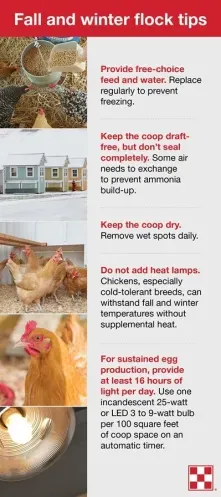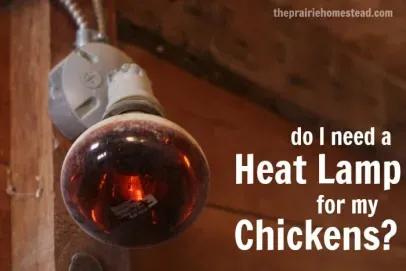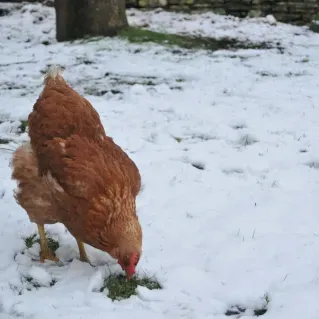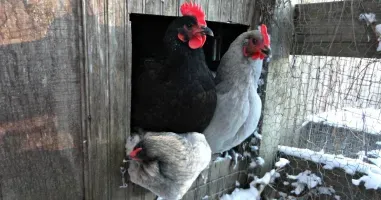Do Chickens need a Heat Lamp in the Winter?
Alright, so picture this: it’s winter, the temperature is plummeting, and you’re snuggled up in your cozy bed with blankets piled high.
Life is pretty good, right? Well, what about your feathered friends out in the chicken coop?
Do they need a snazzy little heat lamp to keep them warm and toasty while you’re catching some Z’s?
That’s the burning question on everyone’s minds, and trust me, the answer might just surprise you. So let’s dive into the world of chickens and their winter weather woes.

This image is property of www.purinamills.com.
Factors to Consider
1.1 Climate
When deciding whether or not to provide a heat lamp for your chickens in the winter, the first factor you need to consider is the climate in which your chickens are living.
If you live in a region with extremely cold temperatures and harsh winters, a heat lamp may be necessary to keep your feathered friends warm and comfortable.
However, if you live in a milder climate where winter temperatures are moderate, a heat lamp may not be necessary.
1.2 Breed
Different chicken breeds have varying levels of cold tolerance. Some breeds, such as the Orpington and Sussex, are known for their cold hardiness and are able to withstand low temperatures without the need for additional heat sources.
On the other hand, some breeds, like Silkies and Polish, have less cold tolerance and may benefit from the extra warmth provided by a heat lamp in the winter.
1.3 Age
The age of your chickens is another important factor to consider. Young chicks are more susceptible to cold temperatures and may require additional heat to stay warm.
Heat lamps can be particularly beneficial for raising chicks during the winter months. On the other hand, adult chickens are generally more cold-resistant and may not need a heat lamp unless they are in extremely low temperatures.
1.4 Housing Conditions
The conditions in which your chickens are housed can also impact their need for a heat lamp in the winter.
If your chicken coop is well-insulated and draft-free, it will provide better protection against cold temperatures.
Proper ventilation is also important to prevent moisture buildup, which can lead to respiratory issues. If your coop is not well-equipped to retain heat, a heat lamp may be necessary to maintain a comfortable temperature for your chickens.
This image is property of farmfitliving.com.
Understanding Chicken Physiology
2.1 Cold Tolerance
Chickens have a natural ability to tolerate cold temperatures to some extent. Their feathers provide insulation and help to trap warm air close to their bodies.
Additionally, chickens have a higher body temperature than humans, ranging from around 104 to 107 degrees Fahrenheit. This higher body temperature helps them to stay warm even in colder conditions.
However, extreme cold can still pose a risk to their health, especially if they are not provided with adequate shelter.
See also Can Ducks And Chickens Live Together You Say?
2.2 Feather Quality
The quality of a chicken’s feathers plays a crucial role in its ability to regulate body temperature and withstand cold weather. Healthy feathers provide better insulation and help to trap body heat, keeping the chicken warm.
If a chicken’s feathers are damaged, matted, or wet, their ability to keep warm is compromised. In such cases, a heat lamp can provide the extra warmth needed to prevent cold-related issues.
2.3 Roosting Behavior
Chickens have a natural instinct to roost, which means they perch on elevated surfaces during the night. Roosting helps them to stay off the cold ground and closer to each other for added warmth.
By understanding your chickens’ roosting behavior, you can ensure that they have appropriate roosting spots in their coop that are away from drafts and provide them with a sense of security and warmth.
This image is property of www.theprairiehomestead.com.
Potential Risks of Heat Lamps
3.1 Fire Hazards
One of the biggest risks associated with using a heat lamp is the potential for fire hazards.
Heat lamps can cause fires if they come into contact with flammable materials. For example, if a heat lamp falls and touches straw or other bedding materials, it can ignite and quickly spread throughout the coop.
It is important to securely install and monitor any heat lamps used and to regularly check for any signs of damage or malfunction.
3.2 Overheating
While heat lamps are intended to provide warmth, there is a risk of overheating if the temperature is not regulated properly.
Chickens have natural thermoregulatory mechanisms, and if the temperature becomes too hot, it can cause heat stress or even death. It is crucial to monitor the temperature in the coop and adjust the heat lamp accordingly to ensure that it is providing a comfortable and safe environment for your chickens.
3.3 Increased Risk of Predators
The use of a heat lamp can attract the attention of predators, especially during the winter months when food sources may be scarce.
The warmth and light emitted by a heat lamp can make your chickens more visible to potential predators such as raccoons, foxes, and even owls. It is important to take appropriate measures to protect your chickens from predation if you choose to use a heat lamp.
This image is property of images.saymedia-content.com.
Alternative Heat Sources
4.1 Deep Litter Method
One alternative to using a heat lamp is the deep litter method. This involves providing a thick layer of organic material, such as straw or wood shavings, on the floor of the chicken coop.
As the chickens scratch and move around, the organic material decomposes, generating heat. This natural heat source can help to keep the coop warm during colder weather. Regularly turning and adding fresh bedding will ensure that the heat generated is consistent.
See also Those Big Mistakes To Avoid When Building Chicken Coops
4.2 Insulated Coop
Ensuring that your chicken coop is properly insulated is another effective way to provide warmth for your chickens during the winter. Insulating the walls, ceiling, and floor of the coop helps to retain heat and prevent cold drafts from entering.
Materials such as foam insulation boards or fiberglass batts can be used to insulate the coop. By creating a well-insulated environment, you can reduce the need for additional heat sources like heat lamps.
4.3 Heated Waterers
Another alternative heat source to consider is a heated waterer. Waterers with built-in heating elements can prevent the water from freezing and provide your chickens with a constant supply of liquid water, even in cold temperatures.
By ensuring that your chickens have access to unfrozen water, their hydration needs are met, and they can better regulate their own body temperature.
This image is property of 2.bp.blogspot.com.
Signs of Cold-Related Problems
5.1 Frostbite
Frostbite can occur in chickens when their exposed body parts, such as combs, wattles, and feet, are exposed to extremely cold temperatures for prolonged periods.
Signs of frostbite include pale, discolored, or blackened skin, which may eventually result in tissue damage or necrosis.
If you notice any signs of frostbite, it is important to take immediate action to protect your chickens from further cold exposure and seek veterinary assistance if necessary.
5.2 Poor Egg Production
Cold temperatures can negatively affect a chicken’s egg production. When chickens are exposed to extreme cold, their energy is diverted towards maintaining body temperature rather than egg production.
This can result in decreased egg laying or even a complete stoppage of egg production. If you notice a significant decrease in egg production during the winter months, providing supplemental heat or implementing alternative heat sources may help to stimulate egg laying.
5.3 Respiratory Issues
Cold weather can also increase the risk of respiratory issues in chickens.
If the coop is poorly ventilated or if there is a buildup of moisture and ammonia from droppings, it can lead to respiratory problems such as pneumonia.
Ensuring proper ventilation and maintaining a clean and dry coop can help minimize the risk of respiratory issues.
If you notice any signs of respiratory distress in your chickens, such as coughing, wheezing, or labored breathing, consult a veterinarian for guidance.
In conclusion, the need for a heat lamp in the winter for your chickens depends on a variety of factors, including climate, breed, age, and housing conditions.
By understanding chicken physiology and considering the potential risks associated with heat lamps, you can make an informed decision about whether to provide supplemental heat or explore alternative heat sources.
It is important to prioritize the health and well-being of your chickens, ensuring they are protected from extreme cold temperatures and any associated risks.




